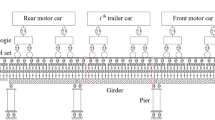Abstract
There exist three problems in the calculation of lateral vibration of the train-track time-variant system at home and abroad and the method to solve them is presented. Spatially coupling vibration analysis model of traintrack time-variant system is put forward. Each vehicle is modeled as a multi-body system with 26 degrees of freedom and the action of coupler is also considered. The track structure is modeled as an assembly of track elements with 30 degrees of freedom, then the spatially coupling vibration matrix equation of the train-track time-variant system is established on the basis of the principle of total potential energy with stationary value and the “set-in-right-position” rule. The track vertical geometric irregularity is considered as the excitation source of the vertical vibration of the system, and the hunting wave of car bogie frame is taken as the excitation source of lateral vibration of the system. The spatially coupling vibration matrix equation of the system is solved by Wilson-ϑ direct integration method. The approximation of the calculated results to the spot test results demonstrates the feasibility and effectiveness of the presented analysis method. Finally, some other vibration responses of the system are also obtained.
Similar content being viewed by others
References
Popp K, Kruse H, Kaiser I. Vehicle-track dynamics in the mid-frequency range [J]. Vehicle System Dynamics, 1999, 31: 423–464.
Knothe K L, Grassie S L. Modeling of railway track and vehicle/track interaction at high frequencies [J]. Vehicle System Dynamics, 1993, 22: 209–262.
Diana G, Cheli F, Bruni S. Interaction between railroad superstructure and railway vehicles [J]. Vehicle System Dynamics, 1994, 23(S): 75–86.
Diana G, Cheli F, Bruni S. Dynamic interaction between rail vehicles and track for high speed train [J]. Vehicle System Dynamics, 1995, 24(S): 15–30.
ZHAI Wan-ming, SUN Xiang. A detailed mode for investigating vertical interaction between railway vehicle and track [J]. Vehicle System Dynamics, 1994, 23(S): 603–615.
ZENG Qing-Yuan, LOU Ping, XIANG Jun. The principle of total potential energy with stationary value in elastic system dynamics and its application to the analysis of vibration and dynamic stability [J]. Journal of Huazhong University of Science and Technology, 2002, 19(1): 7–14.
LI jian, ZENG Qing-yuan, WANG Rong-hui. Stochastic analysis method of lateral vibration energy for train-track time-varying system [J]. Journal of Vibration Engineering (in Chinese), 2000, 13(2): 307–313.
Author information
Authors and Affiliations
Corresponding author
Additional information
Foundation item: Project (50078006) supported by the National Natural Science Foundation of China; Project (2001G029) supported by the Foundation of the Science and Technology Section of the Railway Bureau
Rights and permissions
About this article
Cite this article
Xiang, J., Li, Dj. & Zeng, Qy. Simulation of spatially coupling dynamic response of train-track time-variant system. J Cent. South Univ. Technol. 10, 226–230 (2003). https://doi.org/10.1007/s11771-003-0014-x
Received:
Accepted:
Issue Date:
DOI: https://doi.org/10.1007/s11771-003-0014-x




